The Reincarnation of the Ancients: Analysis and Reflections on the SITI’s The Bacchae
By Staff Writer Mina Yu ’22
As I walked into the Brooklyn Academy of Music (BAM) Harvey Theater, I remembered thinking that there could not possibly have been a better venue for Euripides in all of New York City. The building’s award-winning architectural design included arches flanking the stage and great ionic columns standing guard at intervals between the seats. Its impression — made complete by peeling green paint and the corrosion of the stone walls — was that you were sitting in the Theater of Dionysus in Ancient Greece.

The BAM Harvey Theater | Source: BAM
There were, of course, elements that seemed incongruous to this effect: the glowing exit signs, firstly, and the hundred or so smartphones that audience members used to scroll through their Twitter feed or take pictures as they waited for the performance to begin. This odd yet somewhat familiar contrast was intentional: according to the BAM website, the design of the theater is meant to “create a visceral bridge between the past and the future.” That night, this idea took on additional power as an allegory for how we approach Ancient Greek drama in modern theater-making and specifically how the renowned Saratoga International Theater Institute (SITI Company) tackled the daunting task of making The Bacchae, which premiered in Athens in 405 BCE, both accessible and meaningful to a twenty-first century audience.
In some ways, The Bacchae is the perfect play for such an endeavor. The story is as follows: Dionysus, the god of revelry, madness, and wine who is also referred to as Bacchus, comes to Thebes, and, enraged that the city-state has denied his divinity, puts all the women of the city into a Bacchic trance and sends them careening to the mountains, where they sing, dance, and suckle snakes and wild animals. Though many are willing to accept Dionysus as a god after this display of power, the young, arrogant king of Thebes, Pentheus, is not. After it becomes clear that Pentheus is intent upon ravaging the worshipping women with his army, Dionysus puts madness in Pentheus as well and sends him to the mountain where he meets a gruesome death at the hands of his own mother and aunts.
Though the physical action of the play is certainly specific to its time, the story simmers with conflicts of gender, power, and faith that are still very much potent and present in our society. In the text of The Bacchae, Pentheus is the very epitome of toxic masculinity; he is uncomfortable and outraged at the Bacchic revelers (known as the Maenads) chiefly because it upsets the traditional power structure of his society. As he puts it: “…this is beyond / All bearing, if we must let women so defy us,” and “Must I be a slave to my own slave-women?” Conversely, Dionysus and his followers do not conform to the expectations of their gender through behavior, and the god himself is frequently described as possessing an almost feminine or androgynous beauty. Additionally, the play records Pentheus’s obstinate unwillingness to yield to a new, unfamiliar god and Dionysus’s divine and disproportionate retribution, which bring into question both the nature of divine and mortal power and what separates mortals from the gods.
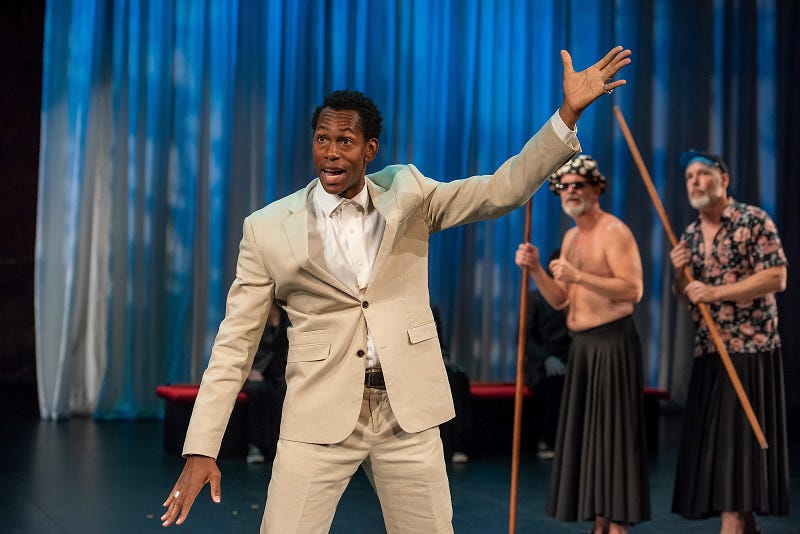
Eric Barryman as Pentheus | Source: BAM
In the SITI production of The Bacchae directed by Anne Bogart, these timeless themes are successfully extricated from its unfamiliar mythical and historical context and brought to the forefront of the audiences’ minds. Every component of this production — from the translation it employed to its casting and costuming choices and its use of certain props in key scenes — contributed to both clarifying Euripides’ intentions to the modern audience and to honing the sometimes ambivalent themes of the play into clear and incisive messages.
With Ancient Greek plays, as with many other older texts in foreign languages, audience comprehension and appreciation for the final performance often hinges upon the translation. The SITI production was blessed with a particularly thoughtful translator who jumped at the challenge of translating for a live theater audience. Poet and literary translator Dr. Aaron Poochigian, whose translation of Aeschylus’s “Persians” was used for the SITI Company’s 2012 production at the Getty, said in an interview with the Nassau Literary Review:
Whereas books of translation can have footnotes, my translation had to be immediately comprehensible. Every word had to land without any outside support. One good example of what I did was translate the cult-title of Dionysus, “Bromius,” as “The Roarer” or the “Roaring God” every time it appears, so that the theater audience would not need a footnote.
As a literary translator, his personal philosophy was also quite compatible to the production’s aim at bringing Euripides’ stories and ideas into the realm of modern comprehension:
I regard the literary translator as a spiritual medium who is “possessed” by the author he is translating. Euripides, for example, took over my body, my memories, my various skills. He wanted his work to be as powerful in 21st Century America as it was in 5th Century BC Athens, so he made me use everything I had inside me… The literary translator is a writer who is willing to surrender his/her will.
Yet, despite his final statement, Poochigian did express some desire to construct his own portrayal of some of the fascinating figures and places of the play, particularly Dionysus: “I did want a chance to put my own stamp on the character of Dionysus/The Stranger — its dangerous sexiness was intriguing to me. Would I be able to capture it in English?”
As it turns out, he was significantly aided in this endeavor by SITI veteran Ellen Lauren, who played an impish yet terrifying Dionysus for the 2018 production. Though Dionysus is traditionally a male role in theater, from the moment Lauren strutted on stage as the god to Screamin’ Jay Hawkins’s song “I Put a Spell on You” with lion-wild hair and red leather pants, it became clear to audience members that there had not been a mistake in casting. In fact, it is strange that more women have not been cast as the god of wine; in Greek mythology, Dionysus is often depicted as both a masculine and feminine deity, and, in the text of The Bacchae, he is frequently described as possessing a “youthful, almost feminine beauty”; that is, he is the very picture of dangerous and explicitly androgynous allure — which Lauren most definitely possesses. Lauren’s Dionysus at times scampers around the stage like an ancient Puck, sloshing wine and frequently breaking the fourth wall to interact with the audience (once handing a glass of wine to an audience member with the words, “This is straight from Joe Melillo’s hands”) and at other times delivers lines with a terrible ferocity that instantly reminds the audience that this utterly charming, funny god is also the same one that drove people to madness and toppled palaces in his fury. In this way, Lauren skillfully captures the fascinating dual nature of the deity, meant to reflect the dual nature of wine, which fills people with revelry and madness both.
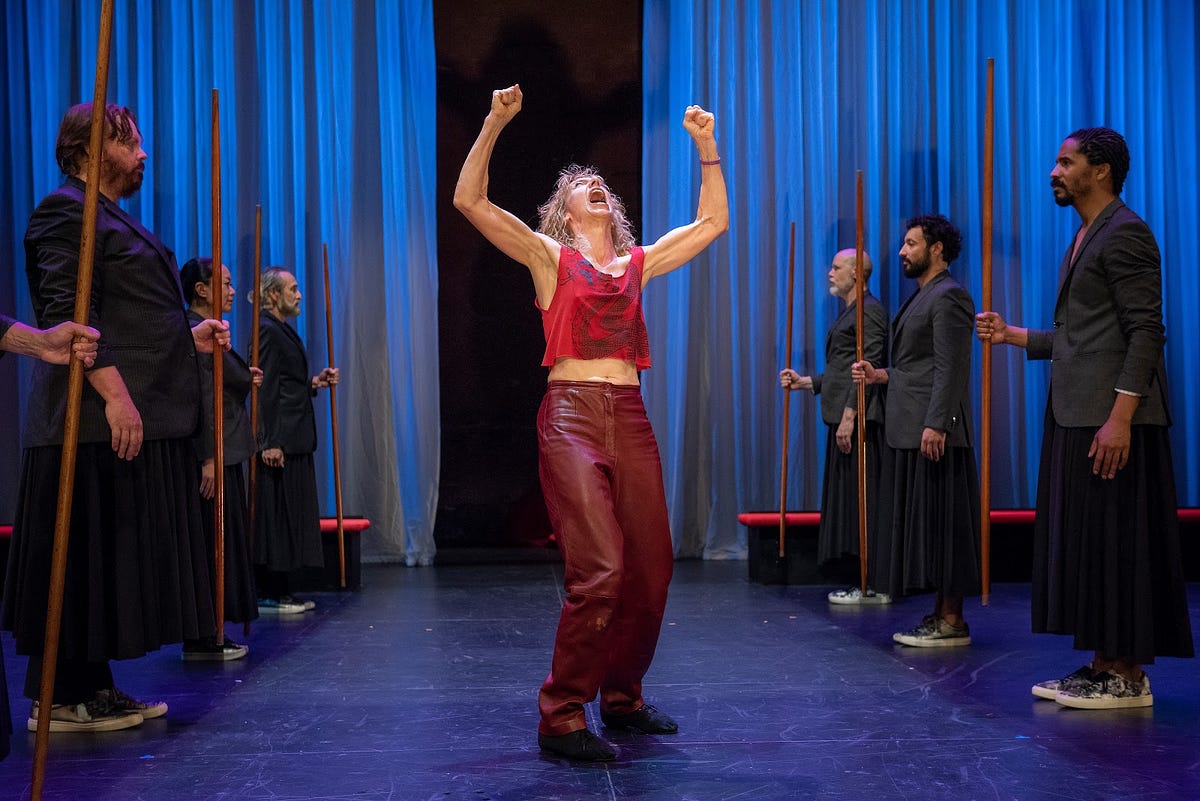
Ellen Lauren’s Dionysus flanked by his worshippers | Source: BAM
The plot of The Bacchae puts Lauren’s wild, gender-nonconforming Dionysus in direct contrast and conflict with the monolithically stubborn and furious Pentheus, compellingly brought to life by actor Eric Berryman. Dressed in a beige suit and stomping heavily about the stage with a perpetual scowl, Berryman is the epitome of unhealthy masculinity and could not be more different from the lithe and mischievous Dionysus, who infuriates him with his teasing wordplay and dancing feet. This, along with the costume choices for the Maenads (who come out dressed in a dark gray blazer and skirt regardless of gender) and for Pentheus during his Bacchic frenzy (whose blond wig and floral sundress complement Barryman’s incredible and frightening depiction of madness), sets Euripides’ depiction of gender-based conflict in The Bacchae in explicit and hyperbolic terms.
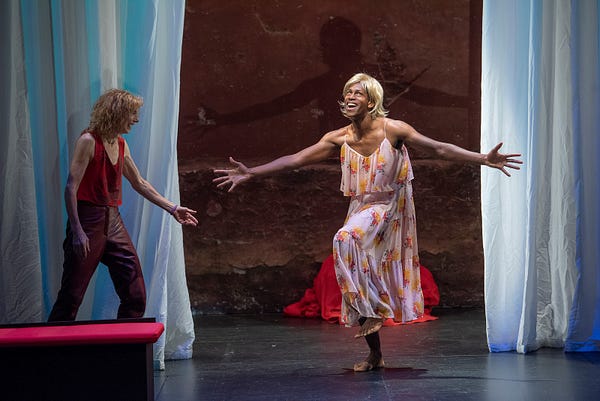
Barryman as Pentheus in his madness | Source: BAM
Another major costume choice in the production serves a slightly different purpose, though still conducive to the overarching goal of delivering the story of The Bacchae to a modern audience. When the blind seer Teiresias (Barney O’Hanlon) and Pentheus’ grandfather Cadmus (Stephen Duff Webber), the founder of Thebes, enter the stage, what was originally a reasonably serious scene takes on quite a bit of humor; the two aged men come out in grass skirts, Hawaiian shirts, and flower crowns as music somewhat reminiscent of SpongeBob plays in the background. Though perhaps not adhering perfectly to its source text, this scene provides some much needed levity to a show that is otherwise quite solemn and, by the end, positively horrifying. In addition, it is not difficult to imagine that seeing the aged actors come out in the garb of the Maenads may have been humorous to the Ancient Greeks as well; it is possible that, by making this choice, Bogart attempted to recreate the experience of watching The Bacchae as faithfully as possible for her modern audience, even replacing ancient tropes that have lost some of its specific connotation over time with those that produce the same visceral reactions for us now.
Undeniably the biggest example of such a trope is the Greek Chorus. The Greek Chorus was an integral part of Greek theater, designed to comment on the action of the play or reveal a reticent character’s inner thoughts, but, just as masks, are no longer common on the modern stage. In The Bacchae, the Chorus represents a group of Maenads that Dionysus has brought over from Asia and other parts of Europe and Greece, and present quite an artistic challenge to the modern director with their long, plot-interrupting tangents describing the worship of Dionysus. The SITI production managed to dodge the possibility of audience boredom or frustration by using various tactics to increase the enjoyability of these odes. For one, rather than having the entire body of the Chorus speak together as they are directed to do for most of the play, most of the lines are spoken by individual Chorus members, which helps move the audience’s eyes around the stage to keep them engaged. In addition, the passages describing the Maenads’ delight in serving their god is appropriately accompanied by rowdy music, bottles and caskets of wine, and, once, even by a microphone each Chorus member would step up to to deliver their line. More solemn passages would be illustrated by patterned movements and the Maenads’ hitting the ground with their staffs at various intervals. All of this not only provided an entertaining break from the intensity of the action of the play’s plot but also helped the audience focus on and digest what Euripides was attempting to communicate through these intervening passages.
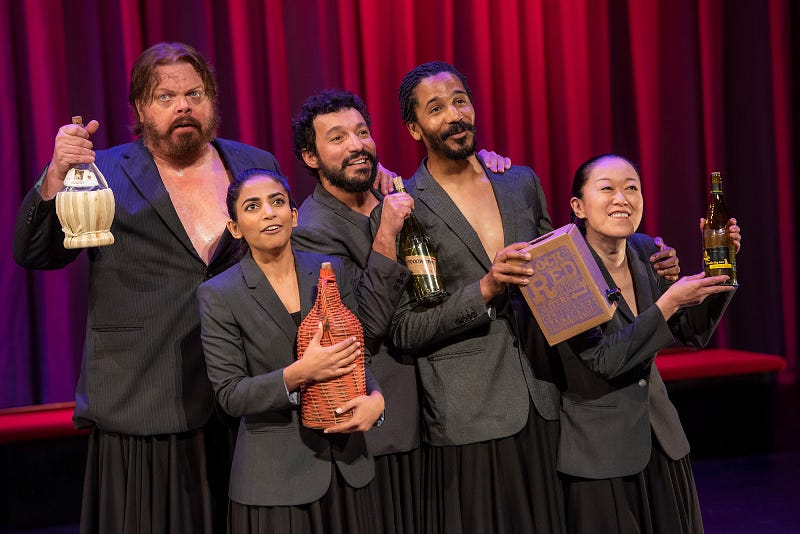
The Greek Chorus | Source: BAM
All of these elements build to create the final scene of The Bacchae, arguably the most affective and disturbing moments of the production, in which Pentheus’ death is described and Agave (Akiko Aizawa), his mother, returns from the mountains holding her son’s head as a bloody trophy, believing that she has just vanquished a mountain lion. In Greek drama, all violence traditionally happens off-stage and is conveyed to the audience by a messenger, and, while the production sticks to the script, the actual effect of what happens on stage during this scene is likely more horrifying than if Pentheus had died center-stage: the stage, which has remained mostly bare throughout the performance, is slowly filled with blood-red curtains that descend slowly and drape across the ground. As the messenger scolds the Maenads for celebrating Pentheus’s horrible death, Cadmus enters, having collected the pieces of his grandson’s body and carrying it in a bloodied burlap sack. Finally, Agave herself enters, giggling as she grasps Pentheus’ head wrapped up in layers of cellophane, his expression barely visible but clearly frozen in his last moments of pain.
It is here that Bogart made one of her most intriguing decisions about the production: Aizawa delivers some of the most distressing and impactful lines of the piece — in which Agave slowly realizes that it is Pentheus who has died, and it was she who killed him — in her native Japanese. Bogart explains her rationale for this decision in the program notes:
For Akiko Aizawa, using her first language allows her to feel and express Agave’s core emotions of grief and understanding as deeply as possible. In our belief that the theater, at its best, transcends language, it is our hope that the eloquence of her emotional intensity will communicate with clarity to our audiences.
Indeed, Aizawa’s incredibly powerful performance of madness and then grief transcends language as she screams and sobs over the head of her murdered son, but the use of Japanese in this scene has an additional, perhaps unintentional, influence on the audience’s experience of Agave’s lines. While she is still under the influence of Dionysus, clearly believing that what she is holding is the head of a lion, it seemed to me, as a non-Japanese-speaking audience member, that she was incomprehensible in her god-inspired madness. In the moments of her great grief, the language barrier brought me to the feeling that Agave’s utter misery, guilt, and loss were something so horrible that no one could possibly understand it. It is a shame that the words had to be lost for this effect to occur (perhaps a full translation could have been provided in the program notes), but Aizawa’s howling and weeping portrayal of Agave hit upon a more primal and visceral grief than words could provide.
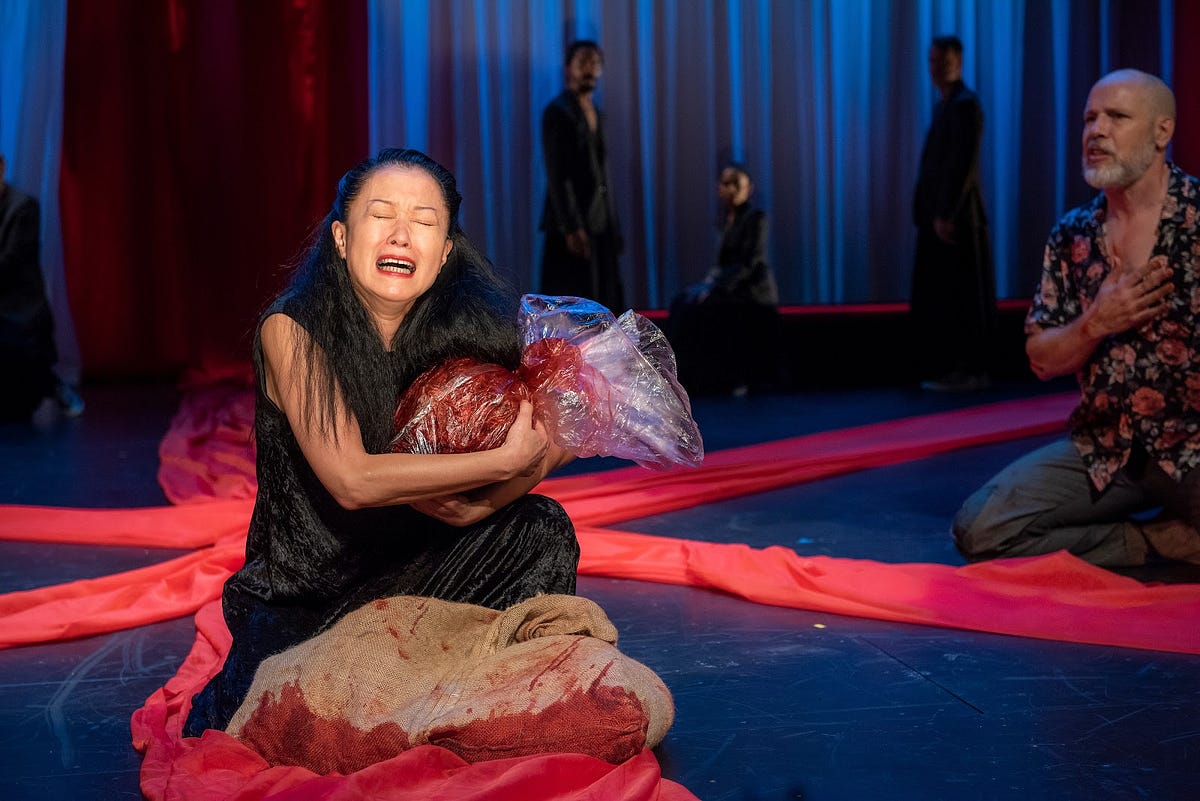
Akiko Aizawa as Agave, violently grieving the death of Pentheus | Source: BAM
In the midst of this destruction, Dionysus comes on, dressed as a janitor and wheeling on a large trash can. As he flippantly mops away the red curtains and throws Pentheus’ body parts into the trash, he dismisses Cadmus’ and Agave’s pleads for mercy and matter-of-factly predicts their fates: Agave is exiled for her crime and Cadmus is turned into a snake along with his wife — it is the end of their cursed family line. It is clear that Dionysus believes this whole matter to be completed to his satisfaction; he has enacted his vengeance and is moving on, unaffected by the events of the evening as he wipes away all trace of the violence from his new domain. But it is clear to the audience, as human beings, that, for Cadmus and his daughters, the pain and the fate that is then more than ever a clearly disproportionate punishment for their crimes will linger and taint whatever is left of their lives with misery. Dionysus’s seeming indifference towards this is frightening. Although the surface-level moral of The Bacchae is that the gods must not be disrespected, Euripides was also trying to communicate that the gods are to us inherently alien beings who, because they suffer no permanent consequences themselves, can enact great injustices upon humanity out of their own selfishness. The duality of wine, and of Dionysus, is also, to the playwright, the reason why the gods must be revered: not only for the wild joy and freedom of the Bacchic rituals, but also out of fear for the utter devastation the god can wreak out of rage or spite. Bogart’s staging and costuming choices during this scene both amplified and clarified this complex message for her modern audience such that it could both be instantly digested and her audience could reflect on how these Bacchic dualities present themselves in their world and how they, personally and as a society, react to the existential uncertainty that follows.
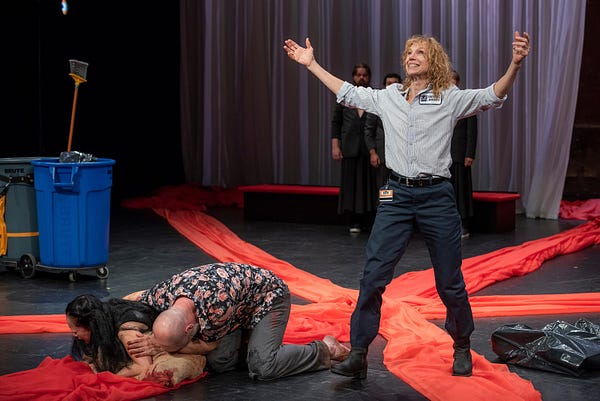
Dionysus revels over his victory as Cadmus and Agave suffer | Source: BAM
The Bacchae is considered to be among Euripides’ greatest work not only because it is a well-constructed tragedy but because it contains themes that take on additional significance in our time. Through its unique choices in the theater-making process, the SITI Company’s production of The Bacchae succeeds not only in making it accessible to its audience but also in honing and amplifying the play’s originally unexplored ideas about gender and power dynamics, producing a work that is more potent and relevant in our society. Though Bogart’s reincarnation of this seminal work is certainly not the masked and tunic-laden performance that we would ordinarily associate with a production of high fidelity, it is my belief that, through her effective translation of the play’s archaic elements to modern ones, she has created something that allows her audience to experience The Bacchae in a way that most closely matches that of Euripides’ audience on an emotional and intellectual level. To be a part of that experience was a joy and a privilege.
You can read the Nassau Literary Review’s full interview with Dr. Poochigian here.